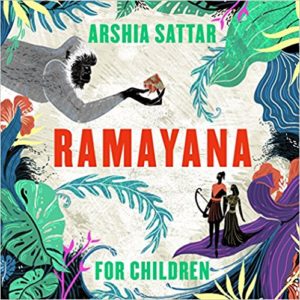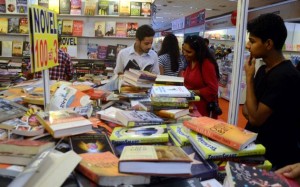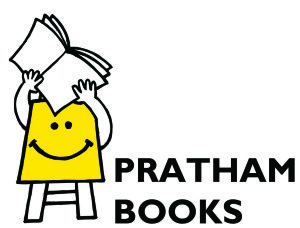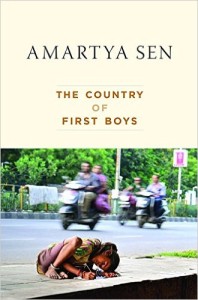Books on religious stories for children and adults
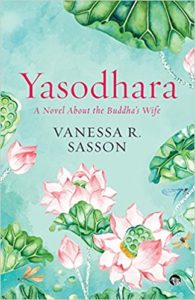 Books on religion will always find readers across a broad spectrum of general readers to believers. It makes good business sense to invest in such books as there will be generations of readers interested in learning these stories while being alive to the times they are written in. So whether it is Yashodhara which is a novel with a strong woman protagonist. Shyam is a beautiful retelling of the Bhagavata Purana or the story of Krishna. Or even a collection of religious stories retold for children.
Books on religion will always find readers across a broad spectrum of general readers to believers. It makes good business sense to invest in such books as there will be generations of readers interested in learning these stories while being alive to the times they are written in. So whether it is Yashodhara which is a novel with a strong woman protagonist. Shyam is a beautiful retelling of the Bhagavata Purana or the story of Krishna. Or even a collection of religious stories retold for children.
Yashodhara: A Novel about the Buddha’s Wife by Vanessa Sasson tries to recreate the times Yashodhara lived in. As professor of Religious Studies in the Liberal and Creative Arts and Humanities Department at Marianopolis College, Quebec, Vanessa Sasson is clear that she has written “hagiographical fiction” and not “historical fiction” as “scholars have yet to determine any material certainty when the Buddha lived (if, that is, he lived at all) and how much of his story might be true”. Also whatever the time period may have been 5 BCE is nearly impossible to recreate as few sources exist narrating what life may have been like at the time. She continus:
The earliest Buddhist writings that we do not possess come later, beginning around the first century CE (more or less). The stories I have spent my academic life reading are based on the memories of a world five hundred years younger than the one the Buddha and Yashodhara probably knew. I cannot begin to imagine all the changes that took place during the time period we lost.
The story I have told here is, therefore, a story inspired by later hagiographies. It is not historical fiction, but perhaps what can be more appropriately labelled ‘hagiographical fiction’ ( if such a label existed). …some of the material in this book is based on early Buddhist literature. Some of it is based on what we know as early Hindu literature. Some of it may be historical, but most of it is not. And some of it has come out of the playfulness of my mind.
Yashodhara begins smartly. There is a crisp pace to the narrative. Some of the descriptions are lovely such as that of the fabrics, the palace, garden landscapes and even that of the monks gathered. Even the conversations are entertaining. As the story unfurls it is obvious there are 21C elements such as the strong women portrayed and grooming of the young Yashodhara by her mother. Then midway the novel the pace became sluggish probably for no fault of the author entirely except that she seems to be torn into two between being too familiar with Buddhism as an academic and that of wanting to a great storyteller. It does not necessarily make the text clunky but it does make it a trifle dull for the lay reader. For Buddhists this novel would be fascinating in its attempt to tell Yashodhara’s story of whom little is known. Yashodhara definitely has the potential to be adapted for television drama.
Shyama is an illustrated retelling of the Bhagavata Purana or the stories of Krishna as narrated by Devdutt 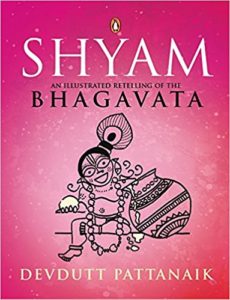 Pattanaik. He has also illustrated the book. The stories are short and neat and told in a manner that only an expert mythographer could convey. For these are stories deeply embedded in an oral tradition of storytelling so over the centuries have morphed and have different versions in existence. But in Devdutt Pattanaik’s deft handling the stories acquire a linear narrative that is easy to comprehend and can be embellished further if required in the telling/a performance. For instance take the story of Shyam and Draupadi which is about the friendship between the two but told ever so beautifully and simply stressing that friendships between opposite sexes were known, acceptable and permissible even in the scriptures.
Pattanaik. He has also illustrated the book. The stories are short and neat and told in a manner that only an expert mythographer could convey. For these are stories deeply embedded in an oral tradition of storytelling so over the centuries have morphed and have different versions in existence. But in Devdutt Pattanaik’s deft handling the stories acquire a linear narrative that is easy to comprehend and can be embellished further if required in the telling/a performance. For instance take the story of Shyam and Draupadi which is about the friendship between the two but told ever so beautifully and simply stressing that friendships between opposite sexes were known, acceptable and permissible even in the scriptures.
… Shyam and Draupadi shared a special bond. She was not his beloved like Radha. She was not his wife as Rukmini and Satyabhama were. She was not his sister as Subhadra was. She was not the haughty princess of Panchala who had snubbed Karna at the archery contest. She was his friend.
It is put forth directly and in a straightforward manner with no room for different perspectives. This is the author’s many years of experience in storytelling at public gatherings and in writing. It has undoubtedly help distill the stories making them easily understood to a contemporary audience.
Every story told in the book is followed by related information placed in a box. For this particular story of the points 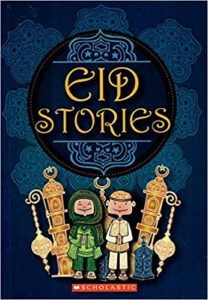 shared one is particularly interesting. Devdutt Pattanaik says:
shared one is particularly interesting. Devdutt Pattanaik says:
Draupadi identifies Krishna as sakha, or friend. Traditionally, men have male friends or sakhas, and women have female friends or sakhis. The relationship between Krishna, a man, and Draupadi, a woman and another man’s wife, is unique.
With the sumptuous Shyama Devdutt Pattanaik has surpassed himself as a storyteller. The layouts are becoming more intricate with the line drawings remaining seemingly simple yet the details are far more elaborate than in his 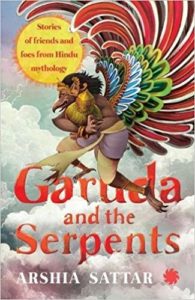 previously published books.
previously published books.
Arshia Sattar has another magnificent book out for children with Juggernaut Books called Garuda and the Serpents. ( Her previous book was the scrumptious Ramayana for Children. ) The well-known stories are told simply but with all the details in place so that if ever a child wanted to narrate these stories orally, it could easily be done. The sequence of events and the action have sufficient details. For the collection she has selected the most popular stories such as Vishnu’s churning of the ocean, Garuda and the serpents, Kamdhendu the magical cow, Vali and Sugriva etc.
A secular outlook is instilled in adults when exposed too all religions in their childhood. The best way of doing so is by sharing with children some of the best stories ever told that have withstood the test of time and these are mostly to be found in different 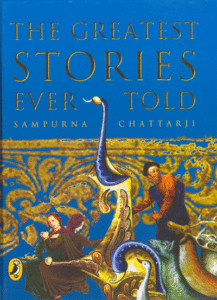 faiths. Some of the recent titles published for children by Hachette India, Scholastic India and Penguin India are still available. Titles such as Eid Stories by Scholastic India, The Greatest Stories Ever Told by Penguin India, and Celebrate! Your Fun Festival Handbook by Hachette India are absolutely worth getting for a child’s personal collection or a school library. These books though published a long time ago are still available.
faiths. Some of the recent titles published for children by Hachette India, Scholastic India and Penguin India are still available. Titles such as Eid Stories by Scholastic India, The Greatest Stories Ever Told by Penguin India, and Celebrate! Your Fun Festival Handbook by Hachette India are absolutely worth getting for a child’s personal collection or a school library. These books though published a long time ago are still available. 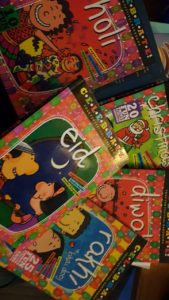
These books are a small step in making those bridges of peace and understanding otherwise willful misinterpretation of religions can lead to the establishment of hostile civil society from which recovery may not be easily done for most people are willing to accept anything as the gospel truth as long as it is in the name of religion. Exposure to other religious beliefs and practices is a way of understanding the “other” rather than perpetuating prejudices and hostile acts of violence. It is the only way forward to have a richly diverse and multi-cultural society co-existing in communal harmony.
Amazon India links to books discussed in the article are embedded in the book cover images and titles given below:
Devdutt Pattnaik Shyam: An illustrated Retelling of the Bhagavata ( Illustrations by the author) Penguin Books, PRH India, 2018. Pb. pp. 280 ( Kindle )
Vanessa R. Sasson Yashodhara: A Novel About Buddha’s Wife Speaking Tiger Publishing, New Delhi, 2018. Pb. pp. 310 Rs 399 ( Kindle )
Arshia Sattar Garuda and the Serpents: Stories of Friends and Foes from Hindu Mythology ( Illustrated by Ishan Trivedi) Juggernaut Books, Delhi, 2018. Pb. pp. 224 Rs 350
Eid Stories (Various authors) Scholastic India, Gurgaon, India, 2010, rpt. 2018. Pb. pp. 114 Rs 195
Celebrate! Your Fun Festival Handbook (Holi, Eid, Rakhi, Diwali, and Christmas) Hachette India, Gurgaon, 2012. Pb. Rs 195
Sampurna Chattarji The Greatest Stories Ever Told Penguin India, Gurgaon, India, 2004. Pb. pp 360.
24 July 2018

